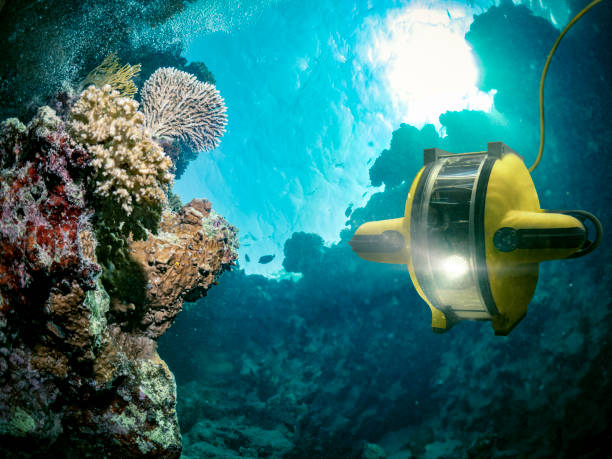
Subsea Robotics: An Overview
Subsea Robotics involve the development & utilization of robotics systems for underwater applications such as offshore infrastructure maintenance, environmental monitoring, underwater exploration, etc. These robotic systems are meant to operate in challenging & often harsh subsea environments, such as deep oceans, underwater infrastructure, and offshore oil & gas installations.
Apparently, the offshore industry is undergoing a crucial shortfall regarding available capacity to carry out pre-consenting, pre-construction site characterization surveys, which are meant to identify the safest and most efficient location for wind turbines and other infrastructure. However, the companies are taking suitable measures to ease this bottleneck, creating greater capacity to service the industry. Bristol-based subsea tech firm Rovco, for example, has launched a new business division with a specialized focus on conducting site surveys essential for the pre-construction phase of offshore renewable energy projects.
“The Subsea Robotics Industry is estimated to grow at a CAGR of around 12.45% through 2028”, Says MarkNtel Advisors in its recent report, titled, Global Subsea (Underwater) Robotics Market Research Report: Forecast (2023-2028)”
In a notable development within the industry, Nauticus Robotics, a manufacturer of subsea autonomous robots equipped with artificial intelligence for data collection and intervention services in ocean-related sectors, announced in April the commencement of commissioning activities for their second-generation Aquanauts, known as the ‘Mark 2’ (MK2). With this, the company intends to deploy the initial units of Aquanaut MK2 to the North Sea and the Gulf of Mexico in the forthcoming months to support various customer initiatives in these regions.
The Aquanaut Mk2 Represents A Fully Electric, Untethered, And Autonomous Subsea Robot
The Aquanaut MK2 represents a fully electric, untethered, and autonomous subsea robot, which operates through acoustic communication networking and is driven by Nauticus’ proprietary software suite, known as toolKITT. Based on artificial intelligence, this software suite encompasses a range of functionalities, including robotic controls, user interfaces, sensor integration, simulation, data analysis, and communication frameworks, all specifically designed to facilitate subsea operations. A distinct feature of the Aquanaut MK2 is its capability to function in two different modes, seamlessly transitioning between excursion and intervention configurations.
Along similar lines, Advanced Navigation, which develops underwater technologies, communications systems, sensors, and robotics, has recently announced Australia’s largest subsea robotics facility in Balcatta, Western Australia. This facility will accelerate the production of underwater technologies, including the Hydrus autonomous robot, meeting the growing demand for high-grade underwater data. They plan to expand their subsea team threefold and deepen their understanding of the oceans. The Perth facility spans 5.5 acres, focusing on development, high-volume production, and ongoing research in subsea navigation and robotics technologies. The new centre boasts comprehensive testing facilities with marine simulations for reliable, high-quality production.
This visionary company’s flagship creation, Hydrus, is a testament to the remarkable advancements in subsea robotics. Hydrus represents a game-changing leap in underwater exploration, research, and surveying. Its design seamlessly integrates a multitude of navigational, sonar, propulsion, and data-capture technologies.
Vaarst Launched Next-generation Robotic Technology To The Us Subsea Market.
In Feb 2023, Vaarst launched next-generation robotic technology to the US subsea market. This resulted from the company’s aim to bring its expertise and abilities in industrial robotics, computer vision, autonomy, and AI technologies to the Americas. The first real-time intelligent data collecting system, SubSLAM delivers high-quality live 3D dense point clouds and 4K resolution video at sub-millimetre accuracy. For asset owners working across the subsea sectors of civils, marine sciences, offshore renewables, and oil & gas, the system will likely emerge as a game changer for the industry, enabling quick visualization with even faster analysis and measurement of vital infrastructure and components.
SubSLAM®, which was created in the UK, tackles several laborious drawbacks of traditional inspection techniques while providing more thorough, measurable data faster than ever before. Asset integrity, UWILD, subsea metrology for building projects, decommissioning, pipeline inspection, cable pre-lay inspection, boulder removal, and coral reef inspections are just a few examples of applications that can be used throughout projects.
Five SubSLAM systems are being brought to the US: two deepwater systems that operate in depths as low as 2000 metres (6562 feet), and three more systems that operate in shallower waters as low as 300 metres (984 feet).
Growing Initiatives for Seafloor Mapping
Seafloor mapping initiatives are gaining recognition globally due to resource exploration, biodiversity preservation, climate change and environmental effects, marine medicine, biotechnology, and other factors. In 2022, the General Bathymetric Chart of the Oceans (GEBCO) reported that just 20% of the ocean floor had been thoroughly mapped. Also, there is a growing movement by nations like the US, India, the UK, and others to explore these uncharted ocean floors. International organizations like the UN, GEBCO, and others are expanding their maritime mapping operations.
What’s Lying Ahead
Innovations in subsea robots are catalyzing a transformative wave in the “blue economy,” reshaping how we harness and explore the vast resources of our oceans. Numerous companies known for their cutting-edge underwater navigation and robotics technologies are at the fore of this revolution. With a profound impact on diverse sectors, their contributions are evident across the maritime spectrum, from research to aquaculture, offshore renewable energy, transportation, surveillance, biotechnology, and high-tech services.

